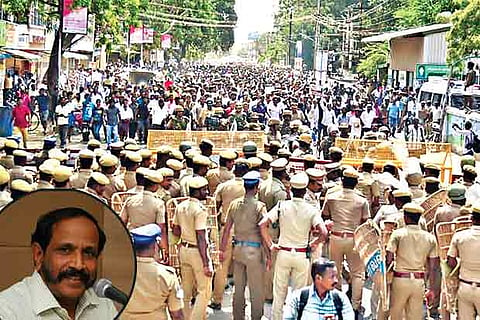

Chennai
There is only one solution to all the problems - ‘Obey the Law ‘ says Naom Chomsky the reputed activist-thinker. It’s true. The way events unfolded leading to the unfortunate incident in Thoothukudi would only conform to that.
It is the duty of the administration to uphold the law and to maintain peace. When that is challenged preventive actions have to be taken.
It is very easy to criticise every step the administration takes but its fairly difficult to implement the critiques of the armchair activists on the ground.
In the past two years, there have been orchestrated attempts to spread discontent, twist issues and instigate hatred among people. The government is always the favourite whipping boy for any mishap, even natural disasters. There is a common tendency is to blame the government.
One could sense a well-planned attempt to denigrate institutions. Judiciary is under attack. Legal pronouncements are denounced with little or no regard for decorum. Law enforcers are criticised and there is continuous attack on the police. Social media is being used to spread misinformation, unverified half-truths and even false news as gospel truth. Pan regional feelings are being whipped up to get validation for the misinformation. In short, the Tamil society is getting isolated from the national mainstream. The Sterlite issue is not new and has been in the radar for quite some time now. But political parties and activists, even minority religious institutions have jumped into the fray to instigate people to join an agitation. This is quite a dangerous trend and the mob violence in Thoothukudi should be viewed in this context.
There are two situations every police officer dreads, police firings and death in custody. The media, with vested interests, and activists with personal agenda tend to project the police as a trigger happy and ever on the prowl to attack the public. This is far from the truth. A policeman is always in fear of failure. In his line of duty anything can happen anytime. He performs under tremendous stress and strain.
Controlling a mob in a law and order situation is both an art and a science. Art, as the policeman has to engage them in dialogue and through tactful persuasion disperse them. Science, when dialogue fails, and he has no other alternative but to use force to quell the mob.
A police officer should be a good communicator. When a crowd assembles to protest, the first point of contact is the police and the crowd tends to show their ire against the symbol of authority first! But at the same time if the policemen engage them in a dialogue, may be sympathise with their cause and tell them to act within the ambit of law, the crowd can be controlled and prevented from turning in to a violent mob. For example, we have witnessed rail roko agitations where the agitators stand in front of the train, pose for the media while they are arrested and disperse. Strictly speaking, a crowd should never be allowed near a train and should be arrested before they even enter the tracks. But to get over the problem for the moment some discretion is exercised by the police at the spot.
Use of firearms to control a mob is the last resort. There is a gradation in the use of force, the principle being, use minimum force at the right time to disperse the mob. The protocol also asks to use less lethal weapons in mob control.
First the police engage the agitators in a dialogue and once the crowd gets to know that the police are firm, they disperse, or the policemen let them achieve some success like meeting the authorities or giving some assurance the crowd may melt away. If that does not work they warn the mob to disperse. The use of force climbs up the hierarchy from tear gas to water canon and finally lathi charge.
Normally lathi charge is very effective as the sight of a policeman wielding a lathi, charging down, is enough to scare anyone. Specialised police personnel are specially trained for effecting a decisive lathi charge and many a battle has been won using this tactic alone.
Only when there is extreme violence and arson does the police resort to firing that too the purpose is to just injure the main instigators. The police have rubber bullets and buck shots with pellets which injure but do not kill. During training, policemen are taught to aim below the knee. There are so many other techniques to control a mob. It is more of a psychological warfare since the police are dealing with their own people and not an enemy.
Details on what culminated to the firing that day are not known but the police must have been forced to use firearms. May be there was an imminent danger to the safety and security of the collectorate staff.
What if the Collectorate was ransacked and buildings gutted posing a danger to the staff? Can the police be a mute spectator in such a situation?
But death due to police firing is most unfortunate and many questions need to be answered. Normally only a musket is used in mob control not automatic weapons. In fact the officer on the spot should keep the arms party totally under his command to ensure they act strictly on instructions.
Tamil Nadu police has faced many challenges in the past. They received bouquets and severe brickbats as well. This is one of their darkest hour but the show must go on. Rain or shine, abuse or pat they have to pursue relentlessly their primary duty to enforce law and order.
— The writer is Mylapore MLA and former DGP
Visit news.dtnext.in to explore our interactive epaper!
Download the DT Next app for more exciting features!
Click here for iOS
Click here for Android